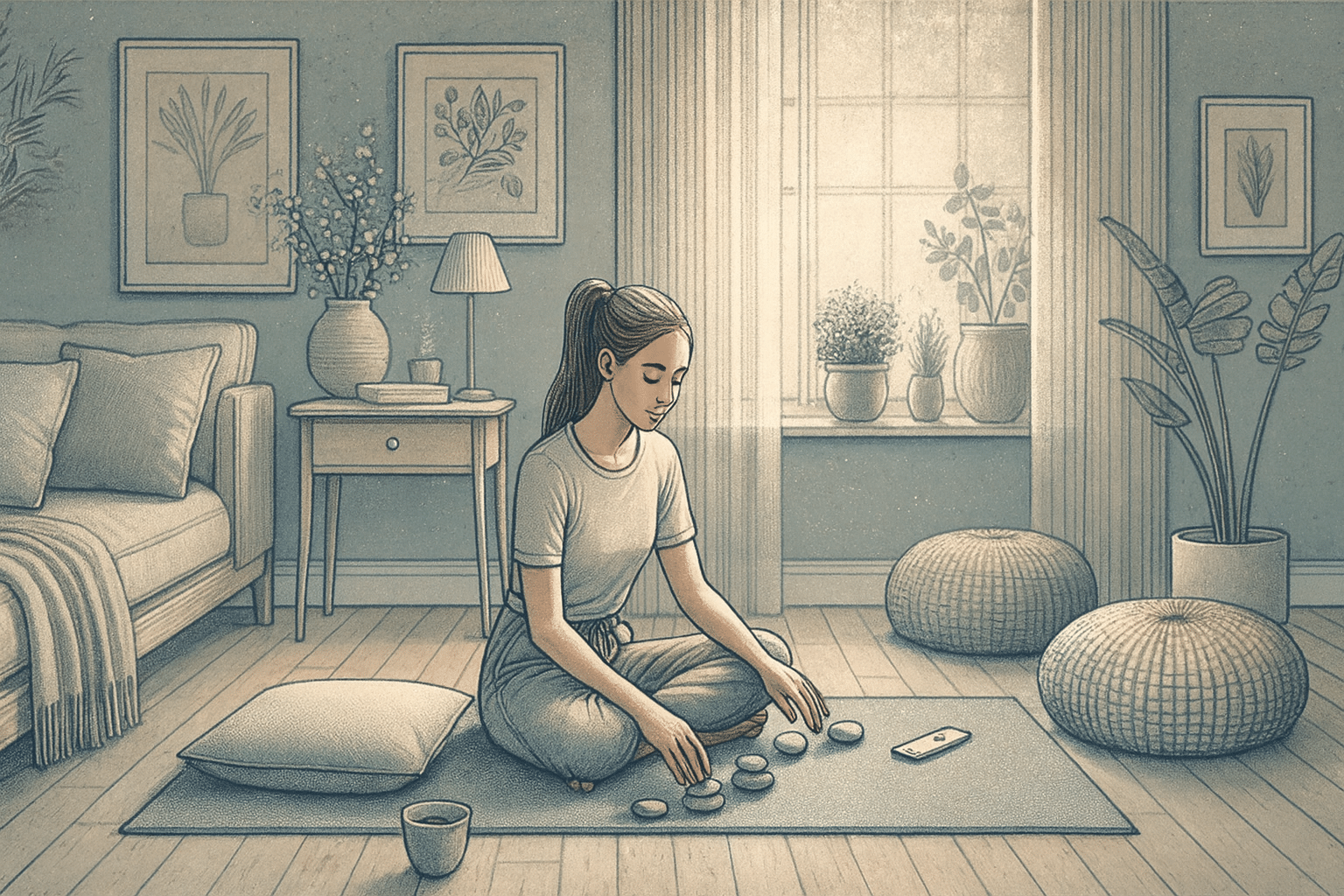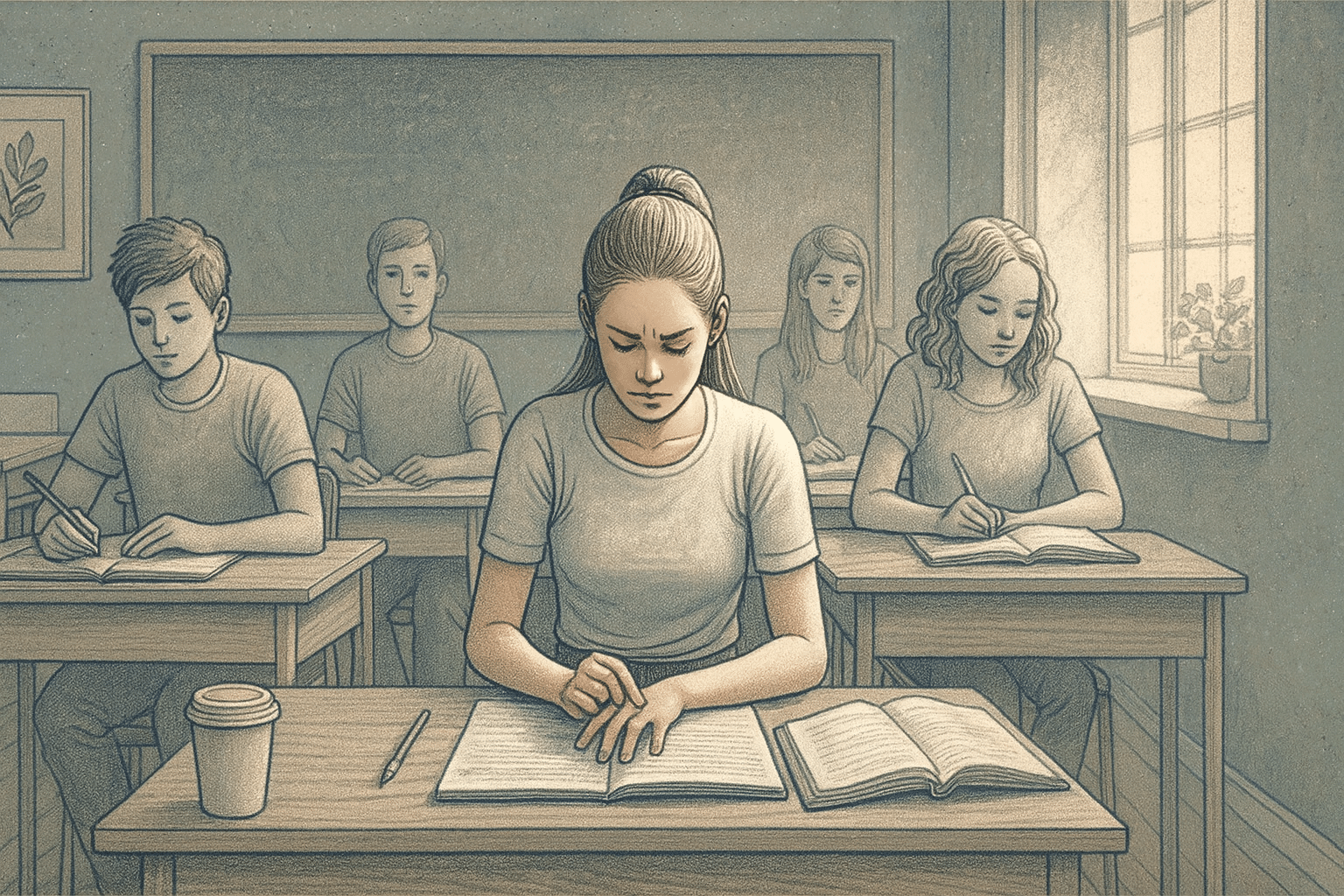Key Takeaways
- OCD compulsions are repetitive behaviors performed to temporarily relieve anxiety caused by intrusive thoughts, not mere habits or preferences.
- Physical compulsions include washing, checking, counting, and arranging, while mental compulsions, like mental review loops and silent counting, often go unrecognized.
- Intrusive thoughts in OCD can revolve around harm, contamination, sexuality, religion, relationships, and perfectionism.
- Effective treatments include Exposure and Response Prevention therapy, which gradually teaches individuals to resist performing compulsions.
- With locations in California, Virginia, and Washington, AMFM delivers compassionate, customized treatment for adults with OCD, anxiety, depression, and related conditions in a supportive, restorative setting.
What Happens When OCD Takes Control: The Compulsion Cycle
When obsessive-compulsive disorder (OCD) takes over, it locks people into a draining loop of anxiety and fleeting relief. It begins with an intrusive, distressing thought that fuels intense anxiety. This sparks the urge to perform a ritual or compulsion, like washing hands, checking locks, or repeating actions, to neutralize the fear or prevent a dreaded event. The relief is brief, but it convinces the brain that the ritual was necessary, making the cycle stronger. Over time, these compulsions often grow more complex and time-consuming, shifting from simple acts to rigid, elaborate routines. They’re not done for enjoyment or usefulness, but as urgent attempts to control unbearable anxiety. Most people with OCD know their behaviors don’t make sense, yet feel unable to stop, sometimes losing hours each day to the cycle.
| A Mission For Michael: Expert Mental Health Care Founded in 2010, A Mission For Michael (AMFM) offers specialized mental health care across Southern California, Minnesota, and Virginia. Our accredited facilities provide residential and outpatient programs, utilizing evidence-based therapies such as CBT, DBT, and EMDR. Our dedicated team of licensed professionals ensures every client receives the best care possible, supported by accreditations from The Joint Commission and the California Department of Health Care Services. We are committed to safety and personalized treatment plans. Start your recovery journey with AMFM today! |
Physical OCD Compulsions You Can See
Physical compulsions are the most recognizable manifestations of OCD, often portrayed in the media and easier for others to notice. These visible rituals serve as the brain’s attempt to neutralize anxiety or prevent feared consequences. While they provide temporary relief, they ultimately strengthen the OCD cycle by reinforcing the false belief that these actions prevent harm.
1. Cleaning and Washing Rituals
Contamination fears often drive some of the most visible OCD behaviors. People may wash their hands until they’re cracked and bleeding, take multiple showers a day, or clean surfaces over and over with specific products and methods. These rituals usually follow strict, self-imposed rules, like washing in a precise order for a set number of times or until they feel “clean enough.” The effort to avoid anything perceived as contaminated can extend to avoiding certain objects, places, or even people. Unlike normal hygiene, these routines continue despite causing pain, injury, and serious disruption to daily life.
2. Checking Behaviors That Never Feel Complete
Checking compulsions stem from an intense fear of causing harm or making disastrous mistakes. Locking doors, turning off appliances, or securing documents might be repeated dozens of times, yet never feel fully “done.” Even after elaborate checking rituals, like inspecting locks, taking photos for proof, or repeating a precise pattern, doubt creeps back within minutes. The worry isn’t just about safety but about imagined catastrophic consequences if something was missed.
3. Counting and Arranging Objects Until They Feel “Right”
Some people with OCD feel an overwhelming need for perfect order or symmetry, arranging items by exact patterns, sizes, or colors. This is mostly about achieving a feeling of “rightness.” Until things are aligned perfectly, anxiety can make it impossible to focus on anything else. Rearranging might take hours, and even a small disruption can trigger the process all over again.

For some people with OCD, arranging objects until they feel “just right” can take hours and become an all-consuming ritual.
4. Repeating Actions a Specific Number of Times
For some, daily life becomes governed by numbers. They may walk through a doorway a set number of times, flip light switches repeatedly, or tap objects in precise sequences. Often tied to magical thinking, these rituals feel essential to prevent harm to themselves or loved ones. “Safe” numbers become non-negotiable, and any interruption can mean starting over; turning simple moments into lengthy, exhausting routines.
Hidden Mental Compulsions Many Don’t Recognize“
1. Mental Checking and Review Loops
Mental checking traps people in an endless replay of memories, conversations, or actions to make sure nothing “bad” happened. They might go over a chat dozens or hundreds of times, looking for proof they didn’t offend someone, yet each review only fuels more doubt. This constant mental rewind can consume entire evenings, leaving no space for the present and leading to exhaustion that can halt normal life.
2. Counting Silently or Repeating Phrases
Some mental compulsions are invisible, like silently counting to a “safe” number or repeating certain phrases to block out intrusive thoughts. These rituals often follow rigid rules about which numbers or words “work.” They can strike anytime; during class, work, or conversation, interrupting focus and draining mental energy, even when the person appears outwardly calm.

Mental compulsions like silent counting or repeating phrases can quietly consume focus, disrupting learning and daily life despite appearing calm on the outside.
3. Mentally Neutralizing “Bad” Thoughts
Neutralizing rituals aim to cancel out disturbing thoughts through strict mental routines, such as picturing a “good” image after an unwanted one or visualizing harm being erased. If a negative thought slips in, the process must start over, sometimes trapping someone for hours. Outwardly, they might seem fine, but inside they’re locked in a battle to reach that momentary sense of safety.
4. Excessive Praying or Confession Rituals
In religious-themed OCD, prayer or confession shifts from faith-driven to fear-driven. Prayers are repeated until they feel “right,” and sins—real or imagined—are confessed endlessly without ever feeling forgiven. The aim isn’t spiritual connection but escaping overwhelming dread, leaving the person with no lasting peace despite constant repetition.
Common Intrusive Thoughts That Trigger OCD
Harm-Related Intrusive Thoughts
These obsessions bring sudden, unwanted images or urges to harm oneself or others, often the very people one loves most. The thoughts are deeply upsetting because they clash with the person’s true values. A caring father tormented by visions of hurting his baby avoided holding her, hid sharp objects, and repeated “I would never hurt her” in his mind hundreds of times a day, even asking his wife to supervise him. The fear wasn’t about desire but about preventing something he’d never actually do.
Contamination Fears and Health Anxiety
Contamination obsessions go far beyond normal hygiene, fueling extreme fears of germs, chemicals, or illness, often with unrealistic ideas about how they spread. Health anxiety may center on catching a specific disease or misreading harmless symptoms as life-threatening. A student so afraid of contracting HIV from public seating stood through lectures and washed her clothes after every outing, despite knowing the virus can’t spread that way.
Sexual and Religious Intrusive Thoughts
Unwanted sexual thoughts can be among the most distressing, especially when they contradict a person’s values or identity, such as fears of inappropriate attraction or doubts about orientation. Religious obsessions, or scrupulosity, focus on morality, blasphemy, and sin. A devout woman plagued by intrusive blasphemous thoughts during prayer spent hours on mental rituals and confessions, yet found no peace in her faith.
Relationship-Centered Doubts and Fears
In relationship OCD, doubt becomes relentless; you might question feelings for a partner or whether the partner truly loves them, no matter how good the relationship is. Compulsions may include endless mental reviews, comparisons to others, or constant reassurance-seeking. One man, despite loving his fiancée, kept examining photos for proof his smile was genuine, never feeling certain enough.
Why AMFM Is Your Best Next Step Toward Healing

AMFM treatment centers provide a supportive, restorative environment where personalized care helps clients focus fully on recovery.
OCD, intrusive thoughts, and compulsive behaviors can feel exhausting, overwhelming, and hard to explain to others. We see the person behind the symptoms, and our entire approach is built to support you in finding relief and lasting healing.
A Mission for Michael’s residential, partial hospitalization, and intensive outpatient programs are designed for adults navigating complex challenges like OCD, anxiety, depression, PTSD, mood disorders, and co-occurring conditions. We combine proven clinical methods such as Cognitive Behavioral Therapy and Dialectical Behavior Therapy (DBT) with compassionate, one-on-one care.
When you begin with us, we start by listening closely to your story, your goals, and your struggles. From there, we create a personalized treatment plan while helping you understand insurance coverage, with many clients having most or all costs covered after deductibles. Throughout your time with us, we stay by your side, monitoring your progress and adjusting your care as you grow.
Our treatment centers in California, Virginia, and Washington are designed to feel calm and restorative, giving you the space and safety to focus fully on your recovery.
Choosing AMFM means choosing a partner who believes in your potential and is committed to helping you reclaim your life. If you’re ready to take the next step toward real change, call us at 866-478-4383 or request a free, confidential assessment. Your healing is our purpose!
Frequently Asked Questions (FAQ)
What exactly are OCD compulsions?
OCD compulsions are repetitive behaviors (like checking, cleaning, arranging) or mental acts (like counting, praying, or repeating phrases) performed to reduce the anxiety caused by intrusive thoughts. They may temporarily relieve distress but ultimately reinforce the OCD cycle.
Are intrusive thoughts dangerous or a sign of intent?
No. Intrusive thoughts in OCD are unwanted, distressing, and not reflective of a person’s true intentions. They are ego-dystonic, meaning they conflict with the sufferer’s values and identity. The danger lies in the distress they cause, not in the likelihood of acting on them.
How can I tell the difference between normal worries and OCD symptoms?
Normal worries are usually temporary and controllable. OCD thoughts are persistent, highly distressing, and feel uncontrollable, often leading to repetitive behaviors or rituals that interfere with daily life.
What treatments are effective for OCD?
The gold standard is Exposure and Response Prevention (ERP), a form of Cognitive Behavioral Therapy. ERP helps individuals face feared situations without performing compulsions, reducing anxiety over time. Medication, like SSRIs, may also be used to help manage symptoms.
How does AMFM help people with OCD?
At AMFM, we treat OCD within our residential, partial hospitalization, and intensive outpatient programs for adults. We blend evidence-based therapies like CBT and ERP with compassionate, personalized care. Our serene facilities in California, Virginia, and Washington offer a healing environment, and our expert team works closely with you through insurance, ongoing treatment adjustments, and support for lasting recovery.






